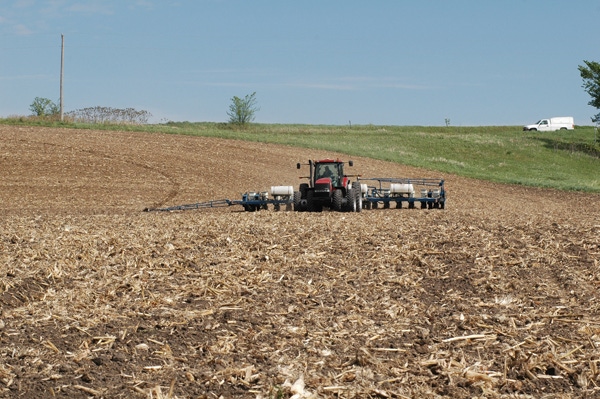April 26, 2011

As of Sunday April 24, only 1% of Ohio’s corn crop was planted, which is 38% behind last year and 13% behind the five-year average. Weather forecasts indicate more rain this week possibly continuing through Thursday. As prospects for a timely start to spring planting diminish, growers need to reassess their planting strategies and consider adjustments. Since delayed planting reduces the yield potential of corn, the foremost attention should be given to management practices that will expedite crop establishment. The following are some suggestions and guidelines to consider in dealing with a late planting season.
Although the penalty for late planting is important, care should be taken to avoid tillage and planting operations when soil is wet. Yield reductions resulting from "mudding the seed in" are usually much greater than those resulting from a slight planting delay. Yields may be reduced somewhat this year due to delayed planting, but effects of soil compaction can reduce yield for several years to come. (Keep in mind that we typically don’t see significant yield reductions due to late planting until mid-May or even later in some years).
If you originally planned to apply nitrogen (N) pre-plant, consider alternatives so that planting is not further delayed when favorable planting conditions occur. Although application of anhydrous N is usually recommended prior to April 15 in order to minimize potential injury to emerging corn, anhydrous N may be applied as close as a week before planting (unless hot, dry weather is predicted). In late-planting seasons associated with wet cool soil conditions, growers should consider side-dressing anhydrous N (or UAN liquid solutions) and applying a minimum of 30 lbs./N broadcast or banded to stimulate early seedling growth. This latter approach will allow greater time for planting. Similarly, crop requirements for P and K can often be met with starter applications placed in bands 2 in. to the side and 2 in. below the seed. Application of P and K is only necessary with the starter if they are deficient in the soil, and the greatest probability of yield response from P and K starter is in a no-till situation. Remember: The longer planting is delayed, the less beneficial a starter with P and K will be (unless the soil test level is below the critical level). The primary reason they are less beneficial is typically at later planting dates soil temperatures are higher (this is not necessarily true for no-till soils and that is why they are more likely to be responsive).
Keep time expended on tillage passes and other preparatory operations to a minimum. The above work will provide minimal benefits if it results in further planting delays. No-till offers the best option for planting on time this year. Field seedbed preparation should be limited to leveling ruts that may have been left by the previous year’s harvest - disk or field cultivate very lightly to level. Most newer planters provide relatively good seed placement in "trashy" or crusted seedbeds.
Don't worry about switching hybrid maturities unless planting is delayed to late May. If planting is possible before May 20, plant full-season hybrids first to allow them to exploit the growing season more fully. Research in Ohio and other Corn Belt states generally indicates that earlier-maturity hybrids lose less yield potential with late plantings than the later-maturing, full-season hybrids.
In delayed planting situations, use the optimal seeding rates for the yield potential of each field. Recommended seeding rates for early planting dates are often 10% higher than the desired harvest population because of the potential for greater seedling mortality. However, soil temperatures are usually warmer in late-planted fields, and as a result germination and emergence should be more rapid and uniform. So, as planting is delayed, seeding rates may be lowered (decreased to 3-5% higher than the desired harvest population) in anticipation of a higher percentage of seedlings emerging.
You May Also Like




